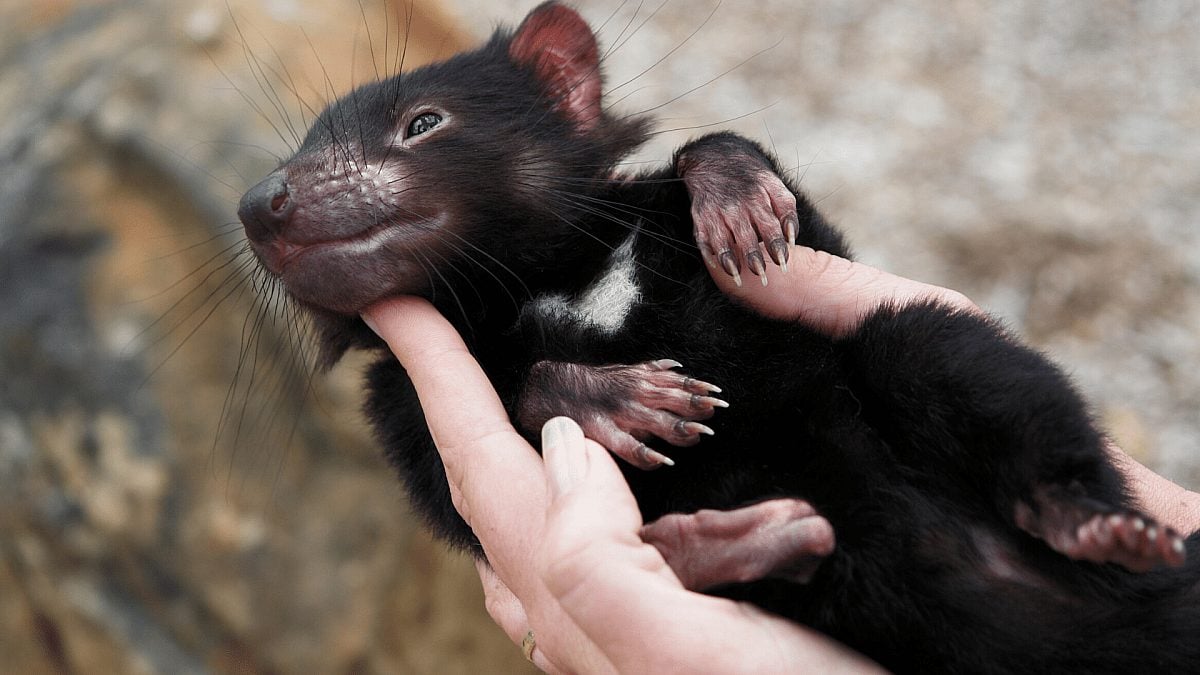
National icon: the Tasmanian Devil
Your guide to one of our most treasured species
Meet the Tasmanian Devil
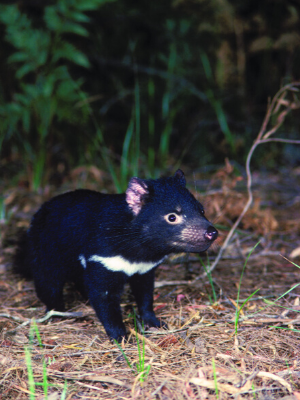
Head to the right spot at the right time and you may be lucky enough to hear the shrieking, haunting cry of the Tasmanian Devil (Sarcophilus harrisii), ringing out over Tasmania's wilderness. Or better still, watch the stocky, dog-like and jet-black animals emerging around dusk to look for carrion to feed on.
Standing 30cm tall and up to 65cm head to tail, the Tasmanian Devil is the largest carnivorous marsupial in Australia. They're a shadow of the big meat-eating animals that once wandered our forests, like the marsupial lion (Thylacoleo carnifex), the largest carnivorous Australian mammal known standing at 75cm-tall at the shoulder, and of course, the near-mythical Tasmanian Tiger.
What the Tasmanian Devil lacks in size, however, it makes up for with bone-crushing jaws and threatening displays of dominance during noisy communal feeding. Without their presence, feral cats and foxes would overtake the island, devastating small populations of mammals like quolls, bandicoots and New Holland mice. They also play a key role in the ecosystem, scavenging and breaking down dead animals.
But our Devils have been having a hard time of late, classified as Endangered thanks to a loss of habitat, a crippling cancerous disease and falling victim to car strikes. However, conservation efforts have made big strides in recent years to ensure the survival of this iconic animal and you can help too, by supporting the Wilderness Society's push for stronger nature laws. This will help protect the Tassie Devil's habitat, places like the national parks and conservation areas detailed below, where you may be lucky enough to hear its haunting, timeless cry.
Top Photo: Dan Fellow
Where to see them
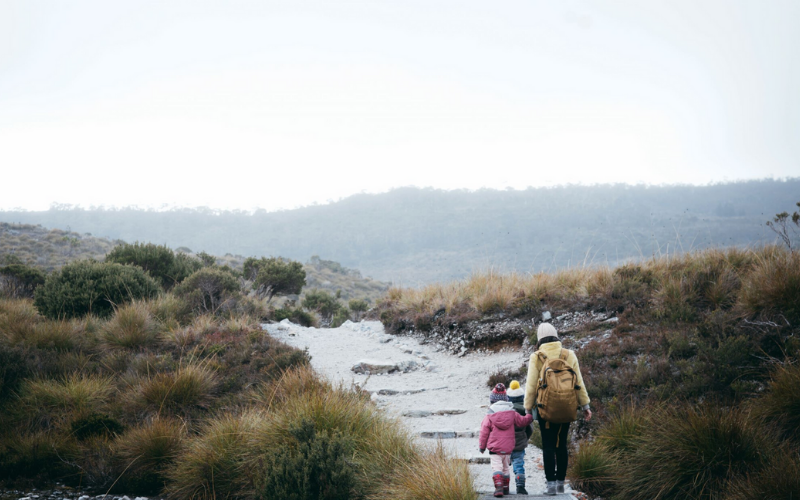
Once abundant across mainland Australia - it's thought that competition with dingoes contributed to their demise 3500 years ago - Tasmanian Devils are now only found in Tasmania. They can be seen all over the island, but are more common in the forests and coastal heathlands of Tasmania’s eastern half and north-west coast. If you're on a mission to spot this Australian icon, here's where to head:
Cradle Mountain - Lake St Clair National Park
Come to Cradle Mountain to tick off one of Australia's most spectacular national parks - but also to seek the Devil. Alpine forests, rainforests and moorlands play host to some of Tasmania's most famous species including platypus, echidnas, quolls and Devils. Keep an eye out for wildlife as you walk the world-famous Overland Track that takes you through the national park's diverse environments. At the entrance to this World Heritage-listed park you'll find the conservation centre Devils @ Cradle, dedicated to the survival of the species. Drop in to learn more about the animals, the conservation work and take a tour for a close encounter.
Central Plateau Conservation Area
Part of the Tasmanian Wilderness World Heritage Area, this mix of moorland, escarpment and forest-lined river valleys provides ideal habitat for Tasmanian Devils that rest during the day in dense scrub alongside seemingly countless wallabies. Known as the Land of a Thousand Lakes, its relatively flat, open landscape makes it ideal for cross-country hiking, leaving the trail to head out to an alpine cabin with a map and compass.
Arthur-Pieman Conservation Area
In Tasmania's north-west is the wilderness of the Arthur-Pieman Conservation Area, covering over 100,000 hectares and forming part of the larger Tarkine / takayna region. Extensive grasslands here run down to the coast giving way to peatlands and dune fields. Pick one of the trails in the early evening to catch sight or sound of a Devil or its smaller carnivorous cousin, the spotted-tailed quoll.
Maria Island National Park
Maria Island is especially important for the Tasmanian Devil. In 2012, conservationists managed to establish a population on the island free from the Devil Facial Tumour Disease (DFTD) , a project vital for the survival of the species (more on this below). The island's forests, ringed by a spectacularly rugged coastline, make it a sanctuary for pademelons, Bennett's wallabies, Flinders Island wombats, Cape Barren geese, Tasmanian native hens and now, Tasmanian Devils.
The threats they face
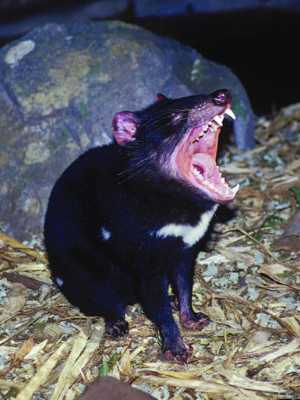
Tasmanian Devils are severely threatened by Devil Facial Tumour Disease (DFTD). Discovered in 1996, the infectious cancer causes the growth of debilitating tumours on the mouth and face. Within a few months, the cancer starts shutting down vital organs – if the animal doesn’t die of starvation first, since the tumours make it impossible to eat.
An infectious cancer with a near 100% mortality rate, DFTD is spread from Devil to Devil through biting. Unfortunately, the raucous, communal feeding of the animals involves frequent fighting and the biting of each other’s faces. This has allowed the disease to spread across 97% of the island, resulting in a devastating 80% reduction in Devil sightings in the last 20 years.
But there is real hope in the form of recent conservation efforts and ongoing research into the problem. For example, 15 Tasmanian Devils free from the disease were introduced to Maria Island in 2012 as part of the Save The Tasmanian Devil Project. The scheme has been successfully breeding the animals and repopulating areas of Tasmania with disease-free Devils where DFTD has caused local extinctions.
Currently, parts of north-western Tasmania are the least affected by the disease. This includes the threatened Tarkine / takayna forest. The Tasmanian Devils in this region have also shown higher genetic diversity than others – an important distinction, since the species naturally has low genetic diversity and is poorly equipped to develop resistance to the disease.
Perhaps even more promising is the fact that a handful of Devils in this region have shown an ability to recover from DFTD, which has almost always been fatal. This makes it even more important that we maintain crucial habitat here to give them the best chance of recovery.
In 2012, the Wilderness Society helped create the Tasmanian Forest Agreement – 500,000 hectares of native forest that would be protected from logging. However, within a few years the agreement was made redundant by politicians, and the habitat of the Tasmanian Devils – including the Tarkine / takayna forest - was up for grabs once more. Despite the Tarkine / takayna Forest being a region least affected by the disease, it is not recognised as a national park. Without protection, the expansion of logging and mining roads still threatens this vital region.
The Tasmanian Devil deserves a chance to not just survive, but thrive. Solving the problem of DFTD will mean nothing if these charismatic creatures have nowhere to return to.
What you can do to help
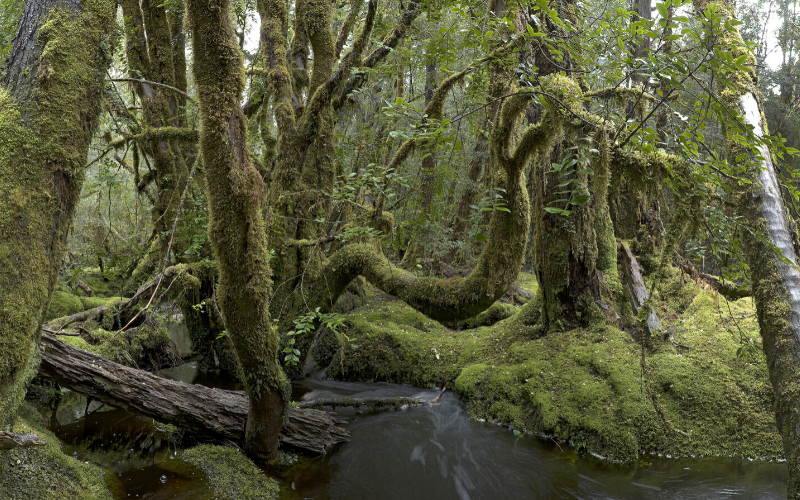
It was the fight for Tasmania’s environment that gave rise to the Wilderness Society, which continues to push for the expansion of the state's network of national parks. Australia needs strong, new laws and an independent watchdog with teeth to support the forests that the Tasmanian Devil calls home. We’re working with the community to transform these forests into national parks and reform the logging industry that's turning them into woodchip. For the critical Tarkine / takayna Forest, we’re advocating for World Heritage protection.
You can help the Wilderness Society protect Tasmania's forests and Tasmanian Devil habitat for future generations by pushing for proper environmental protections.